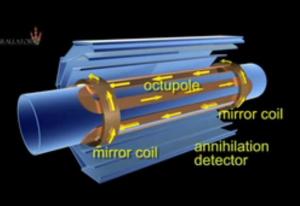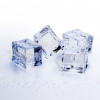Spin and antimatter
Interview with
From a distance the laws of physics and the Universe at large look pretty symmetrical. But, drill down into the fabric of the matter we're made of, and some glaring asymmetries emerge. Chris Smith spoke to particle physicist Ben Allanach from  Cambridge University...
Cambridge University...
Ben - It's a weird thing when you look at your hands and they look as if they've got mirror symmetry. They don't look particularly different. And macroscopic large objects don't seem that different through a mirror. But the weird thing is, when you look at the smallest bits of matter; particles like electrons, the outer bits of atoms, they look asymmetric in a very special way. And also, there's an asymmetry between matter and anti-matter which is very important for our existence.
Chris - When you say an asymmetry, I mean, let's just back up a bit here because when we're talking about matter and antimatter we're going right the way back to the Big Bang and the fact that energy gets converted into material in the Universe. And there's not really a fundamental reason why we shouldn't have equivalent amounts of matter and its mirror-image equivalent anti-matter. But, what we see the Universe is made of is matter...?
Ben - That's right. We're all made of matter. There's not much anti-matter around at all. You can make it at places like CERN when you convert energy the other way into matter and anti-matter. The question is, why did we end up all being matter? If you do the sums in the early Universe, the early Universe was a hot cloud of gas and there's matter and anti-matter bouncing around. If you work out the equilibrium of that, you're going to get pretty much equal amounts to a very good statistical average.
Chris - Based on our present models...
Ben - Yeah, based on our present understanding of physics and experiments like CERN give us that understanding.
Chris - But, obviously, when we make the observation, we see we're all made of matter and, as you say, anti-matter, is vanishingly rare. So where's it all gone?
Ben - In fact, when you bring matter and anti-matter together, of course, they annihilate into radiation. So particles of light for example will come out of that. And so, the question is more, why aren't we all made of light, right? Because if you have equal amounts...
Chris - Well some of us are stars aren't we Ben, like you?
Ben - That's right. I think I'm a bit heavier than that! So, there's got to have been some slight difference between matter and anti-matter. In fact, in the particle physics experiments at the end of last century, those differences were starting to come out. So, they feel forces very slightly differently, not to a large extent but if you do the theory of what's going on, you need a slight difference between how matter interacts and how anti-matter interacts, along with some other conditions in the early Universe. And you get a slight tilting that favours one over the other and, in this case, favours matter over anti-matter. And you have to follow all this complicated maths through, but as long as you've got a slight tilting - there's 15 billion years in between where lots of boring things happen - but we end up, luckily, being made of matter and not light!
Chris - But I mean, I was watching Frank Close talking the other day. He's got a video on the internet from when he was giving his talk at the Royal Society - because he got the Faraday Medal this year for public understanding of science - and he was making some of these points. He was sort of saying, "Do you think it's a mistake, or just by chance, that we have arrived at this situation where physics means that we can exist and we're not just energy or light? Or do you think it's extraordinary that, when we compare the nucleus of an atom and the charge on a proton its exactly counterbalanced by the charge on an electron? But then an electron is just one thing whereas if we zoom in on a proton, it's actually got three other little particles inside it. Those are the quarks aren't they? And actually, there are three of those but two of them are sort of 2/3'rds, the other is 1/3, and they balance out to be about the right amounts so that it completely opposes an electron and the two counterbalance. That's extraordinary and it's too much of a good outcome to be chance, isn't it?
Ben - Yeah, I mean the accuracy on those charge measurements is fantastic. I mean, it's one in ten to the ten or something, but I think there's an underlying reason for that. The underlying reason could be the Grand Unified Theory which says that the particles which make up a proton and the electron are two different aspects of some underlying particle where an asymmetry has been introduced in that which splits the two off but it explains exactly why you have this quantization of charge. And the charge of a quark comes in multiples of a third of the charge of the electron. So, there are other examples of theories where you get a precise mathematical relation between the charges of things. I suspect, it's probably due to that, rather than I don't know, there being a billion universes and you just pick at random one where we can exist.
Chris - Are you not in favour of the idea that there might be multiple universes? This is the sort of Michio Kaku parallel universes where we just happen to inhabit the one where the rule of physics work for us.
Ben - The problem I have with it is that you can't test that theory. So, it's really interesting to speculate about it, but I don't think we can ever know even in principle and so, it's outside of science.
Chris - I thought the whole idea was, we're trying very hard to detect gravity waves propagating because the theory says, if we've got these parallel universes then gravity ought to be able to transit between them. And therefore, if we can see the waves of that gravity coming from one to the next, it sort of says they exist. Do you think that because we haven't found it therefore that disproves that these parallel universes can exist then?
Ben - No. The question is, is there any point in space and time where our universe is connected to one of these so-called parallel universes? If there is, I'd count that as being part of our universe because where space is....
Chris - Isn't that mathematical trick, Ben. Are you being crafty?
Ben - That's what we do. That's what we get paid for. No, I mean, if it's connected in space and time it is part of our universe. But you're right. If you've got some foaminess, you should be able to detect that. But I don't count that as this multiverse theory, but it would certainly be very interesting if most of the time, it's not connected, but you know, back on Tuesday last week, it was and you could detect the gravitational radiation from that. That would be one way of me eating my words. But if it goes the other way and you don't see the gravitational radiation, you can't say one way or the other and I suspect that that's going to be the case. And so, that's my problem with it.
Chris - Steven Driver...
Steven - That's just wiped out a whole genre of science fiction!
Chris - Oops! Chris, in your book, Right Hand, Left Hand, you actually make the point early on in there - and this is something that Pasteur said in the early days - that, asymmetry begets asymmetry. So, starting with the asymmetries in the tiny particles that Ben studies, that leads actually up to a whole organism - or even a whole world - with gross asymmetries in it...
Chris M. - That's right. If you keep backtracking whenever you find an asymmetry, something else must have caused it and you can keep going back and back, and back and you end up exactly where Ben is, yeah...










Comments
Add a comment